Vineyard Machinery Review: Kubota M5-002N-series narrow tractor
28th July 2023
Kubota has introduced new M5-002N-series narrow tractors with updated features which are certain to increase appeal for specialist fruit growing and vineyard applications. F&V machinery editor, David Williams, enjoyed an exclusive test-drive of the first of the new models to come to the UK.
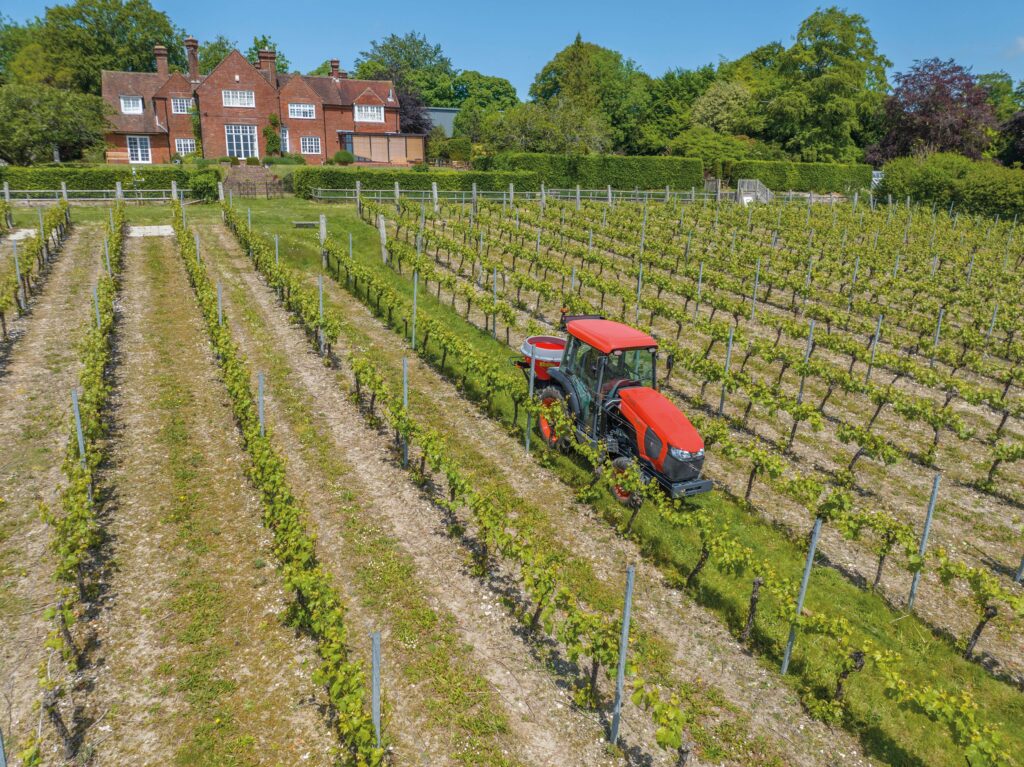
Fruit & Vine spent a day at Hambledon Vineyard in Hampshire, test-driving the latest Kubota M5-002 Narrow tractor.
New narrow models with proven engineering and extra features
The new M5-002N narrow tractors fill a gap in the Kubota line-up, created when M5-001N series production ceased two years ago. Dealers and loyal customers have been looking forward to the new model’s arrival, and demand is expected to be particularly strong as the new features attract interest from existing customers as well as those currently using competitor brands.
Although Kubota offers several model variations for other world markets, just the M5-102N is available initially in the UK.
“Previous experience as well as current market analysis suggests that this model will suit the vast majority of fruit and vineyard applications,” explained Kubota UK product and key account manager – ag tractors, Jonathan Rook, at the Fruit & Vine demonstration.
Engine and transmission
The M5-102N is powered by a Kubota V3800 engine, with 3.8 litres capacity, four cylinders, and turbocharging, producing up to 106hp and 346Nm of torque. Crucially, it meets latest Stage 5 emissions standards using AdBlue. The complete emissions control module has been squeezed in under the engine hood, avoiding the need for an external chamber, and minimising the effect on the driver’s view.
For the UK market, a manual transmission with three ranges, six gears, plus a high and low range electronic-activated splitter giving 36 forward and reverse gears is available, with direction changes through an electronic shuttle lever by the steering column. The clutch is hydraulic.
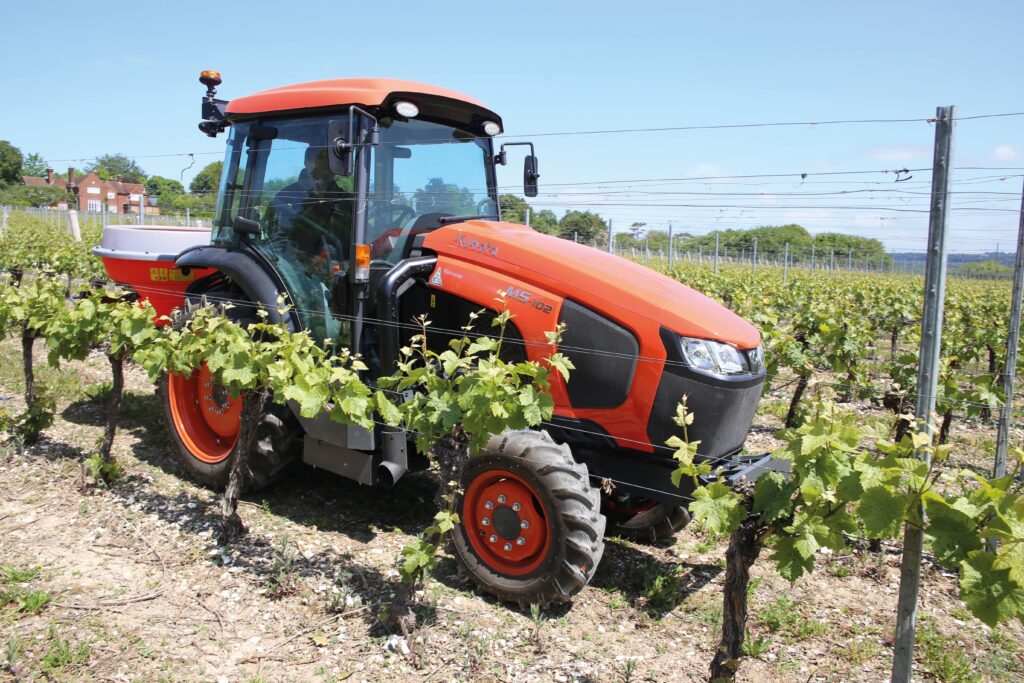
The M5-102N has a 106hp engine, meeting Stage 5 exhaust emissions.
Operator environment
The cab is like before, but includes air conditioning as standard, plus an uprated air-suspension seat. For the first time, it is available with Cat 4 operator protection for spraying. It has six pillars, but these are narrow and those at the rear are close-spaced, so there is an excellent view from the seat in all directions. The two curved rear corner windows can both be opened, allowing the operator to obtain fresh air without having to open the larger rear window. LED lighting is standard on the new model.
When Cat 4 filtration is fitted, the operator selects the correct filter depending on the task. The working time is monitored, and an alarm alerts the operator before the 600-hour filter service life is reached.
The cab floor is almost completely flat, with just a small, raised section following the line of the transmission tunnel. This is despite the relatively low cab height. Many competitor tractors of similar height rely on a lower cab floor either side of the transmission tunnel, which means that the driver’s legs must remain in the confined footwells.
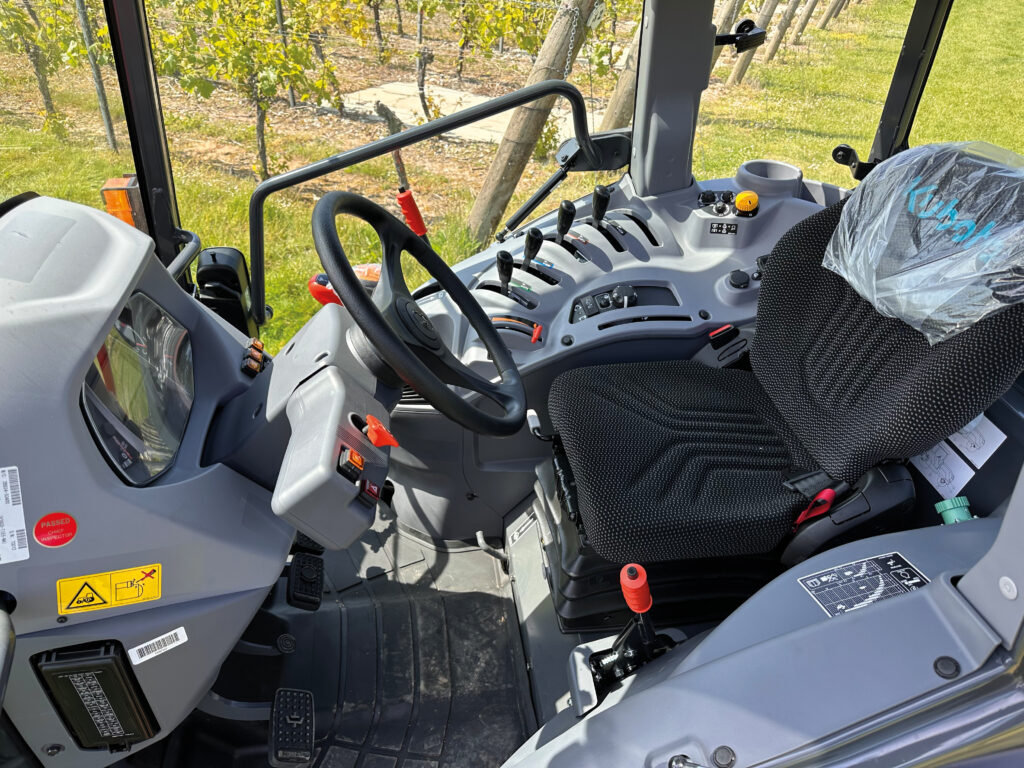
Electronic hydraulic controls are an option – adding external linkage control which makes it easier to hitch up implements. There is electronic engine speed management, which ensures constant revs are maintained – even as working conditions alter.
User-friendly controls
The shift, and gear change levers are on the right, just ahead of the main control panel. Changes up and down through the six gears can be made on the move, but for range changes the tractor must be stationary. The gear lever has two electronic buttons. One operates the dual-speed splitter, and the other activates the clutch, allowing gear changes without the foot clutch pedal.
The shuttle lever is to the left of the steering wheel. It has three positions – neutral, forward and reverse, and allows clutch-less direction changes on the move.
There are two handbrake levers. On the right side, near the gear selectors is an Independent Park lock lever that engages the 4wd shaft, and on the left is the secondary brake used to make emergency stops.
The rear differential lock is engaged by a foot pedal close to the cab floor, under the right side of the seat.
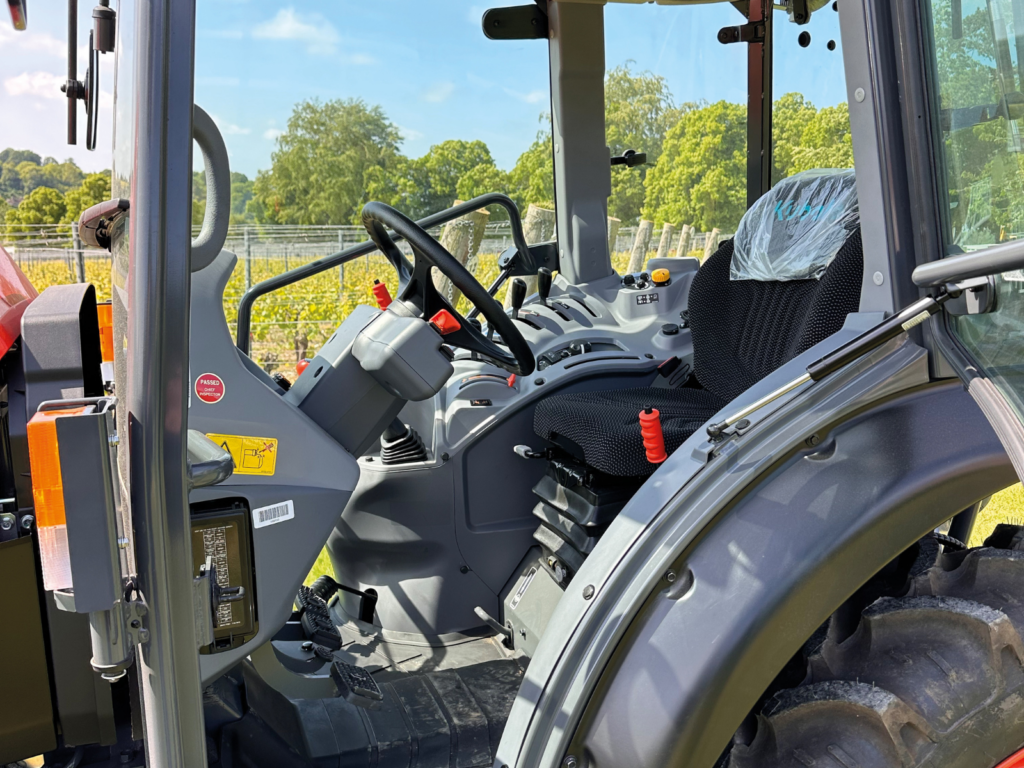
The cab is like before but includes significant upgrades. Cat 4 operator protection for spraying is a new option.
Front axle suspension
Front axle suspension is an option, but Jonathan Rook expects it to be a popular addition. Two large accumulators absorb impacts and there is 95mm of suspension travel for effective performance on very rough ground. The suspension is easily adjusted from the cab through two buttons. One selects off, on or auto modes. In the ‘off’ position, the axle is kept rigid. In the ‘on’ position, the suspension is active across the full speed range and, in ‘auto’, the suspension adjusts automatically to suit the driving speed and conditions.
The second button selects the degree of damping, to suit the implement, ground conditions and type of work. In ‘fixed’ mode, the suspension is stiffer with less response – ideal for heavier implements, and in ‘normal’ mode an appropriate amount of damper movement is automatically selected. In ‘soft’ mode, the suspension responds quickly for a smoother
ride across uneven surfaces.
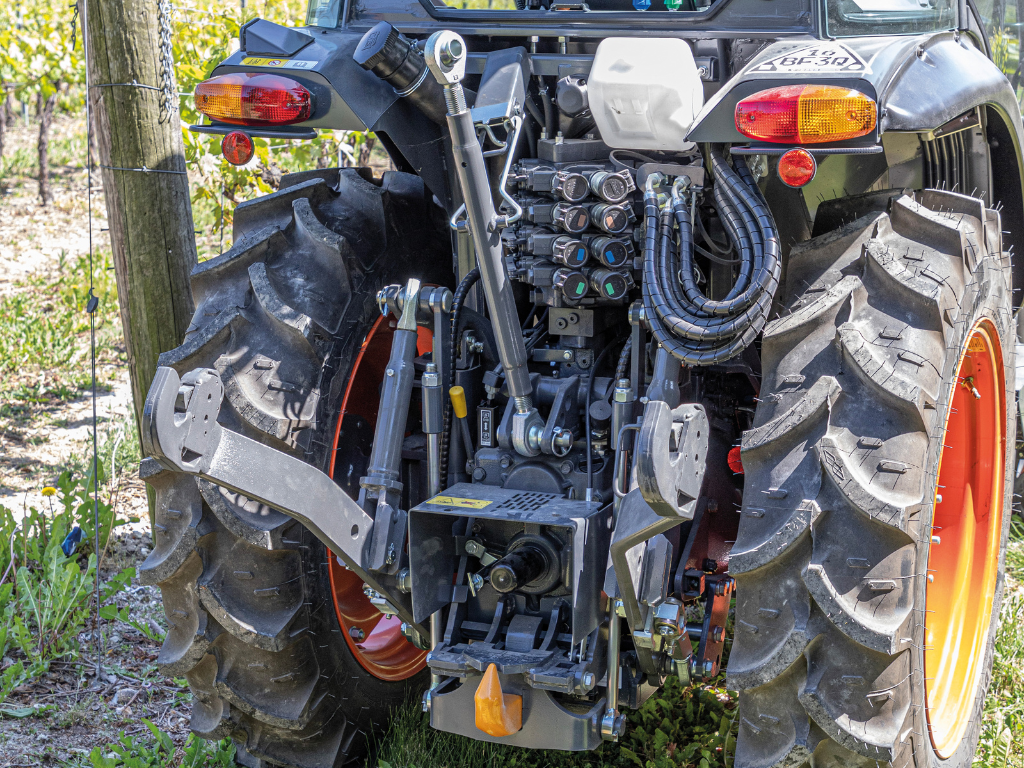
Up to five mechanical spools can be fitted, or four if electronic rear hitch control is fitted.
Capable hydraulics
The hydraulic spool control levers are on the main control panel, and a rocker button and rotary dial operates the hydraulic linkage. PTO drive activation is self-modulating, so that engagement is smooth whatever the load.
Hydraulic spools are available with manual control. A maximum of five can be fitted with mechanical control and up to four if electronic rear hitch control is fitted. The electronic option also includes external linkage operation through buttons on the rear mudguards, making it easier to hitch and unhitch linkage-mounted implements. Hydraulic oil flow rates are adjusted using convenient twist controls behind the seat. Colour-coding matches the rear spool outlets,
to ensure the correct control is used.
Optimising performance
The dashboard includes large, clear analogue gauges on the right side for fuel level and temperature, and on the left displaying engine rpm. The central Intellipanel LCD display shows essential information including travel speed, PTO speed and AdBlue tank level, and it can also display the exhaust particulate filter state and working hours data.
Two engine speed memories can be set; adding convenience for repetitive tasks carried out at constant speeds or requiring constant revs. For field work, the user can complete headland turns and then immediately return to the pre-set speed at the touch of the dashboard-mounted button.
Constant RPM management is new. When this mode is selected using a switch on the dashboard, the engine speed will be kept almost constant within a certain level of load fluctuations. This improves working accuracy without the need to manipulate the travel speed and hand throttle lever, and is a useful addition when powering complex implements that require a constant operating speed. Isobus implement control is an option, along with a wide range of precision farming applications available by fitting Kubota’s 7in or 12in K-Monitors.
Many of the latest multi-row sprayers use Isobus control to manage complex systems, and the Kubota terminals offer full compatibility with all aspects of precision operation including GeoControl, variable rate applications and section control.
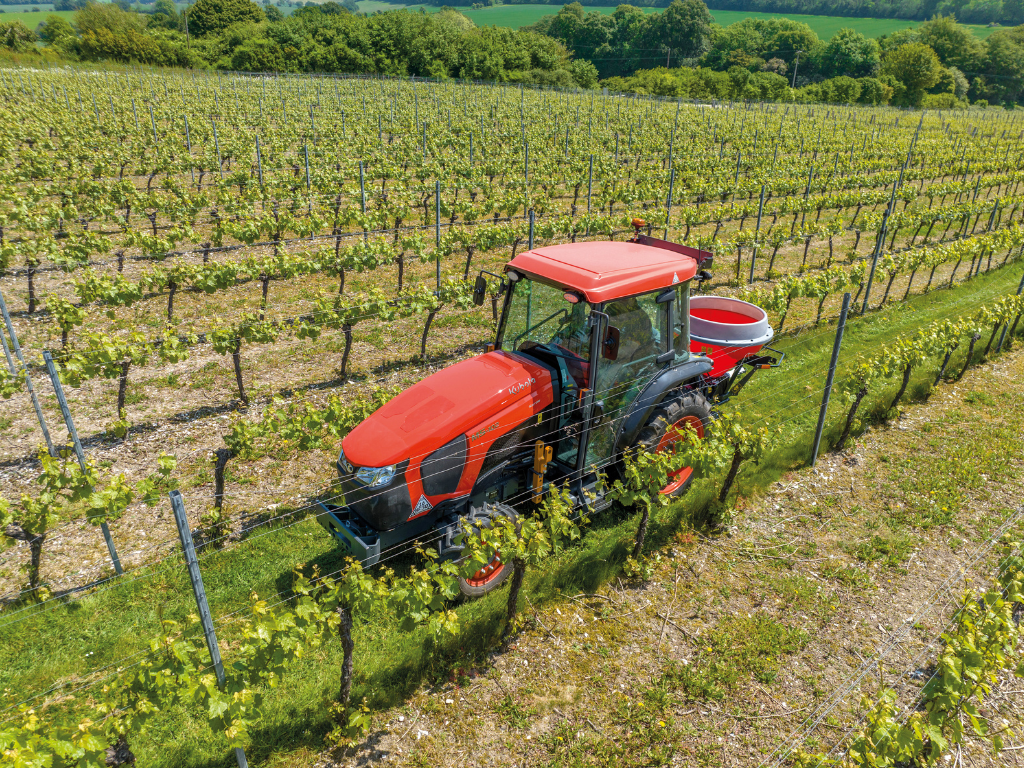
Two engine speed memories can be set; adding convenience for repetitive tasks carried out at constant speeds.
Sizes to suit
On its standard 280mm wide front and 360mm wide rear tyres, the overall width of 1.45m is narrow enough for orchard work and operation in modern vineyards with wider spaced rows, but for traditional closer vine row spacing, narrower 7.5in front and 11.2in rear tyres are also an option for even narrower widths.
Highly manoeuvrable
The new M5-002N tractors retain the previous models’ portal axle design, maximising ground clearance and allowing a tight steering angle. For even better manoeuvrability, the tractors also have a selectable bi-speed turn mode, causing the front wheels to speed up once the steering angle exceeds 35 degrees, and pulling the front of the tractor in the steering direction. This allows tight turns at the end of each row for consecutive row working without the need for shunting. The bi-speed mode can be disengaged when it isn’t needed, and to protect sensitive grass areas from scuffing.
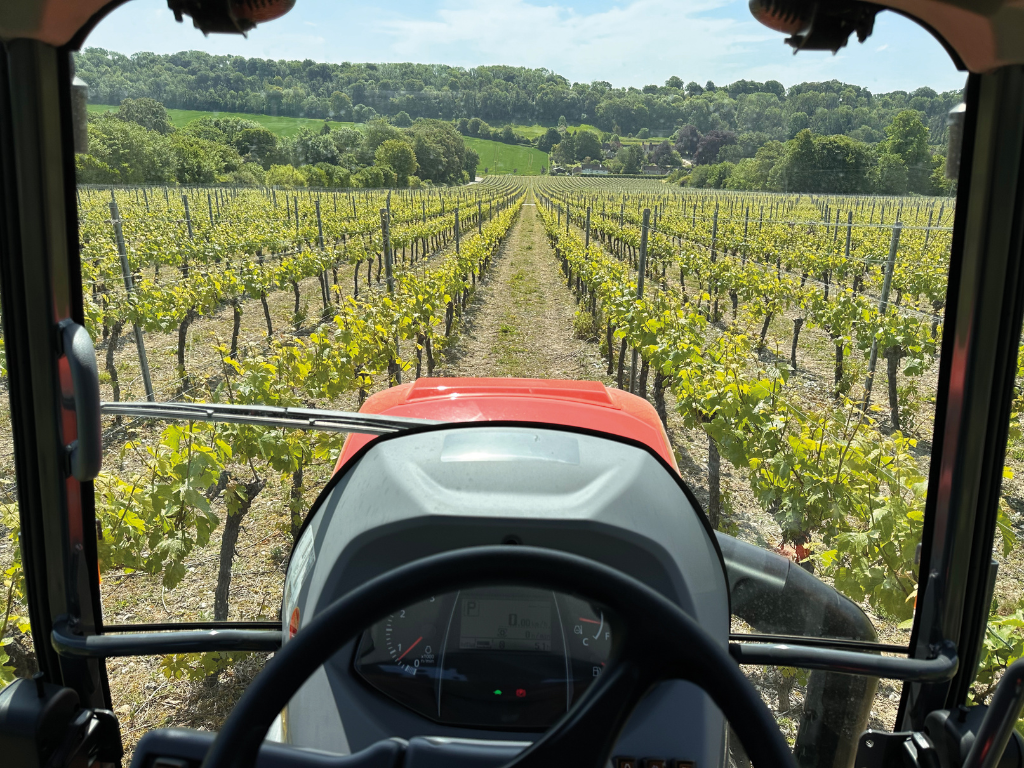
The design is functional and user-friendly. All the controls are logically laid out, and clearly labelled.
Test drive
Access to the cab is very good, through the wide opening left-hand door. The steering wheel tilts up to 40 degrees, allowing plenty of space between the seat and dashboard. The flat floor also makes it easier to get in and out of the cab.
The design is functional and user-friendly. All the controls are logically laid out, and clearly labelled. Once the engine is started, then the operator selects the appropriate gear range – Low, Medium or High – and then the appropriate gear. The dashboard display clearly indicates whether high or low splitter range is selected. The forward/reverse shuttle lever is moved in the required direction of travel, then the operator uses the foot accelerator or the manual engine speed control to select appropriate revs.
Clutch take-up is very progressive, making it easy to move distances of just a few millimetres at a time – handy for lining up pins when attaching implements, or the pick-up hitch when connecting a trailer.
There is no adjustment for the rate of drive take-up when the shuttle lever is used. This means that using it without the main clutch is only possible at lower speeds.
Changing up and down through the gears using either the foot clutch or push-button clutch control, it is easy to achieve smooth changes, especially when the low and high splitter range button is used simultaneously to ensure a close speed match.
The standard of finish is high, and although the Fruit & Vine test-drive included travel along uneven tracks and across undulating terrain,
there were no rattles or vibrations.
The air conditioning worked well, quickly reducing the temperature inside the cab to a comfortable level in the warm weather. Driving around the site as well as between vine rows, the visibility was excellent. The large front screen provides a wide unobstructed view, and although the new engine hood is slightly larger than before to accommodate the new emissions control system, the sloping top makes it easy to close in front of the machine and down to the
front wheels.
The large side windows give a good view to both sides and the rear quarter windows allow a partial view between the rear and the sides reducing any blind spots, which is an advantage when manoeuvring in tight spaces.
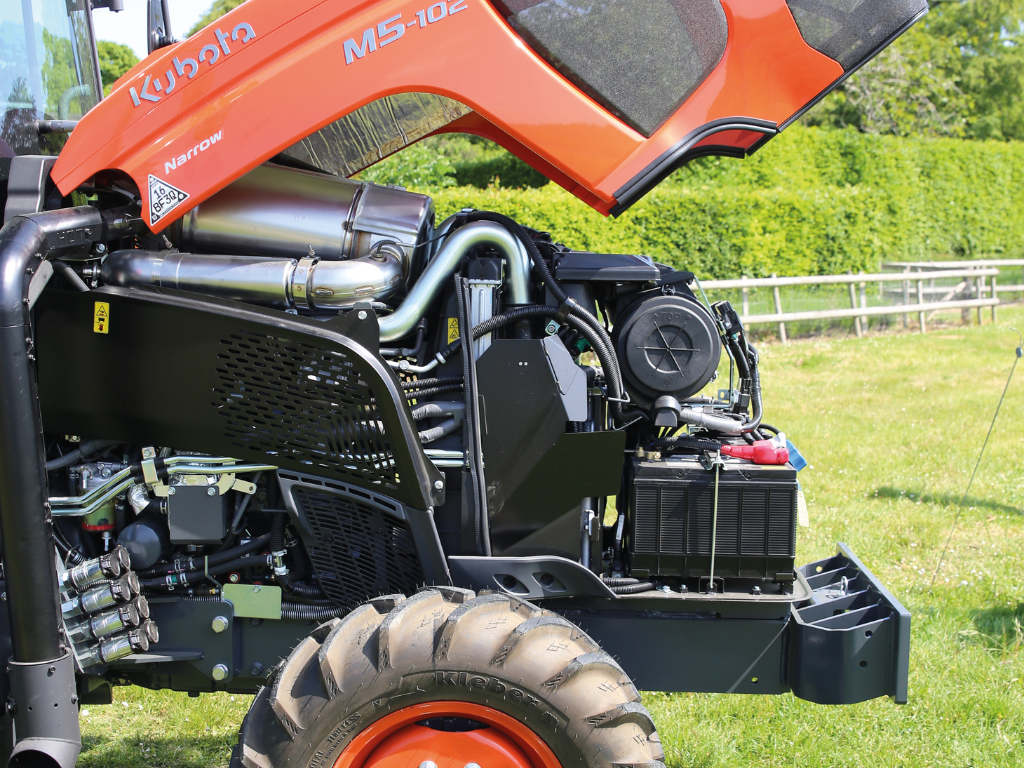
Access for daily checks and servicing is good. The Stage 5 emissions control system is compact and fits under the engine hood so there is no external SCR chamber to obstruct the driver’s view.
Service and maintenance
Service access is good, making the tractor easy to look after. The diesel filler is at the rear, and the AdBlue filling point is at the front, accessed by lifting the engine hood which means there is little chance of putting the wrong product in the wrong tank.
The engine oil dipstick is adjacent to the filler on the left-hand side, and it is accessed without lifting the hood. The dipstick is short, making it easy to remove, check the level, and replace the stick without risking contamination.
Engine service intervals are every 500 hours and the diesel particulate filter needs servicing every 6,000 hours. Filter regeneration requires engine revs of only 1,100rpm to maintain the correct temperature – providing fuel savings compared to the previous system which needed 2,000rpm. The standard warranty is two years, but a five-year warranty fully backed by the manufacturer is available.
Pure Kubota
“The new M5002 Narrow tractors are 100% Kubota,” confirmed Jonathan. “Almost every mechanical component is made in Japan by Kubota, including the engine, transmission, axles, cab and hydraulic systems. There is huge attention to detail and the quality control is exceptional, so we expect these tractors to share the same legendary reliability as other models in the Kubota line-up.”

Hambledon Vineyard manager, Nick Cran-Crombie says that the three Kubota tractors used currently by the vineyard are well built and reliable, but he believes that the new M5-102N offers additional useful features to boost productivity and improve operator safety.
Vineyard view
Hambledon Vineyard is the UK’s oldest commercial vineyard and produces award-winning sparkling wines from grapes grown on site. Wine production started there in 1952, and the current owners purchased the site in 1999 with 18ha of vines. The business has since expanded, and now there are 75ha of vines, producing half a million bottles per year. Buyers include Marks & Spencer, Waitrose and Virgin Atlantic, as well as selected restaurants.

Nick Cran-Crombie
Most of the vines are planted with 70–90cm spacing in 2.2m rows. “The site lends itself to machine operations, although we pick all the grapes by hand,” explained vineyard manager,
Nick Cran-Crombie.
Three Kubota M5-series narrow tractors are used, including two bought in 2019 and another purchased in 2020. “We looked at alternatives before buying Kubota, but when we matched the specification the Kubota was a more cost-effective investment. Since we have had the tractors, the first two have clocked up 2,000 hours each, equivalent to 400 hours per year, but we have had very few issues, and no actual breakdowns.
“The main tasks are transport around the site, spraying, trimming and vegetation management using flail mowers. They do everything really and we have found them to be robustly built and extremely reliable.
Nick was interested to try the latest Kubota M5002 narrow tractor on his site. “Our own tractors aren’t due for updating for a few more years, but our positive experience of Kubota, as well as our local dealer, means we are unlikely to select anything else. One of the big attractions is the new optional front PTO and linkage. We are keen to make the most of mechanisation to increase work rates and operate more efficiently, and if we can complete multiple tasks in a single pass, then it must be an advantage.”
Other advantages of the new tractor identified by Nick include the Cat 4 operator protection. ““Anything that keeps our operators safer has to be a good thing,” he continued. “That is something we would specify. We use a Lipco recirculation sprayer which recovers droplets from the air while spraying which is better for the environment and reduces our chemical use. Compared to our previous sprayer, we are saving up to 500 litres of chemical mix for every 10ha of vines.”
“Everyone here rates our current Kubota tractors, and the new model has useful improvements. Our priority is our vines and wine production. We just want tractors that work well, without complications,” he stressed.
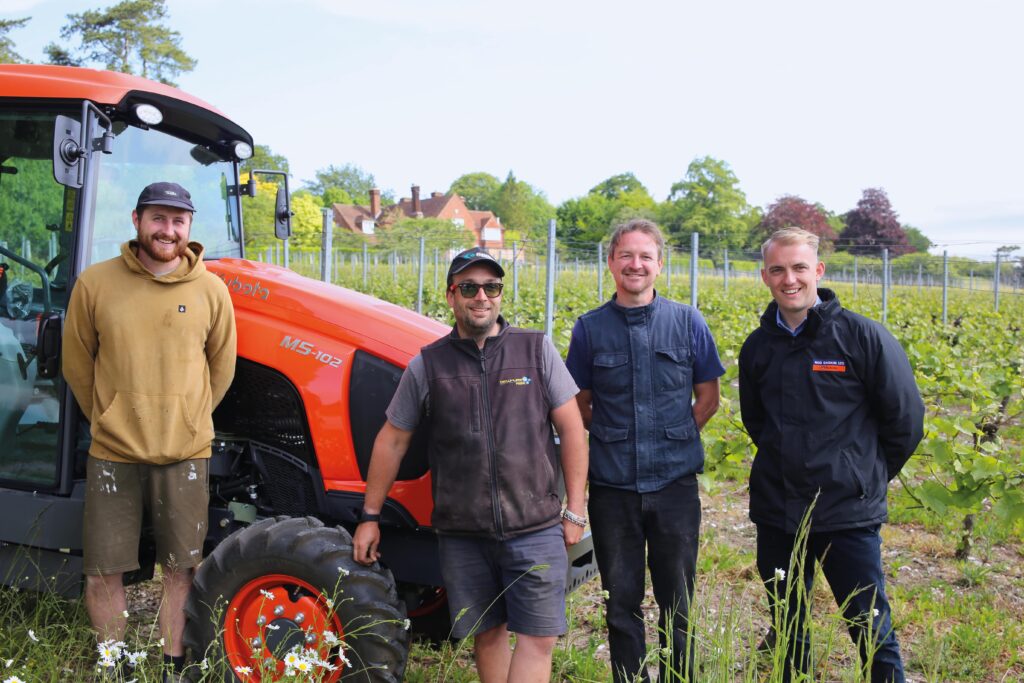
Pictured with the new tractor (l-r): Red Admiral Contracting macinery operator, Tom Randall and owner Dan Smith, with Nick Cran-Crombie, and Kubota dealer Rod Gaskin agricultural and groundcare sales specialist for Hampshire and Sussex, Tom Merrit-Smith
Specialist contractor view
Also present at the demonstration were Dan Smith and Tom Randall of Droxford-based grape producer and vineyard contractor, Red Admiral Contracting.
“As well as producing our own grapes, we also provide a contracting service to approximately eight other vineyards, including Hambledon Vineyard,” explained Dan.
“We offer a full range of services including spraying and variable-rate fertiliser applications. The vineyard work is carried out using Kubota tractors supplied by Rod Gaskin Ltd, and we have already ordered a new M5-102N which will work alongside our existing machines.
“It’s on wide tyres, and equipped with a front linkage and PTO, as well as GPS guidance. We get on very well with the brand.
“Kubota tractors have a simple design and are very reliable, and our current tractor has worked 1,400 hours since it arrived in 2019 and has been faultless. When we need anything the dealer provides great back-up, and we have never been let down.”
Dealer view
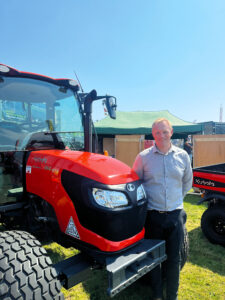
Tom Gaskin from Kubota dealer, Rod Gaskin Ltd
Kubota dealer, Rod Gaskin Ltd operates from depots near Alton, Hants and Haywards Heath in West Sussex, and supplied and looks after the Hambledon Vineyard tractors.
“We have been Kubota since 2009 offering the full range of tractor and groundcare products,” director Tom Gaskin told Fruit & Vine. “We chose Kubota for its excellent reputation for reliability and durability across all the markets it serves.
“We believe that the updated narrow tractor will have broad appeal across our customer base. The improved, standard specification will benefit everyone, while the option of electric linkage and mid-mounted hydraulic valves gives the machine extra versatility for more specialist applications. These improvements will suit the changing requirements of Hambledon Vineyard, as well as our other customers needing specialist narrow tractors for orchard and vineyard applications across the South.”
